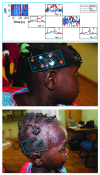Implementing neuroimaging and eye tracking methods to assess neurocognitive development of young infants in low- and middle-income countries
- PMID: 31508580
- PMCID: PMC6719506
- DOI: 10.12688/gatesopenres.12951.2
Implementing neuroimaging and eye tracking methods to assess neurocognitive development of young infants in low- and middle-income countries
Abstract
Infants and children in low- and middle-income countries (LMICs) are frequently exposed to a range of environmental risk factors which may negatively affect their neurocognitive development. The mechanisms by which factors such as undernutrition and poverty impact development and cognitive outcomes in early childhood are poorly understood. This lack of knowledge is due in part to a paucity of objective assessment tools which can be implemented across different cultural settings and in very young infants. Over the last decade, technological advances, particularly in neuroimaging, have opened new avenues for research into the developing human brain, allowing us to investigate novel biological associations. This paper presents functional near-infrared spectroscopy (fNIRS), electroencephalography (EEG) and eye tracking (ET) as objective, cross-cultural methods for studying infant neurocognitive development in LMICs, and specifically their implementation in rural Gambia, West Africa. These measures are currently included, as part of a broader battery of assessments, in the Brain Imaging for Global Health (BRIGHT) project, which is developing brain function for age curves in Gambian and UK infants from birth to 24 months of age. The BRIGHT project combines fNIRS, EEG and ET with behavioural, growth, health and sociodemographic measures. The implementation of these measures in rural Gambia are discussed, including methodological and technical challenges that needed to be addressed to ensure successful data acquisition. The aim is to provide guidance to other groups seeking to implement similar methods in their research in other LMICs to better understand associations between environmental risk and early neurocognitive development.
Keywords: EEG; eye tracking; fNIRS; global health; infancy; low-and middle-income countries (LMIC); neurocognitive development.
Conflict of interest statement
No competing interests were disclosed.
Figures








Similar articles
-
The Brain Imaging for Global Health (BRIGHT) Project: Longitudinal cohort study protocol.Gates Open Res. 2024 Sep 5;7:126. doi: 10.12688/gatesopenres.14795.2. eCollection 2023. Gates Open Res. 2024. PMID: 39372355 Free PMC article.
-
Functional near infrared spectroscopy (fNIRS) to assess cognitive function in infants in rural Africa.Sci Rep. 2014 Apr 22;4:4740. doi: 10.1038/srep04740. Sci Rep. 2014. PMID: 24751935 Free PMC article.
-
Habituation and novelty detection fNIRS brain responses in 5- and 8-month-old infants: The Gambia and UK.Dev Sci. 2019 Sep;22(5):e12817. doi: 10.1111/desc.12817. Epub 2019 Mar 13. Dev Sci. 2019. PMID: 30771264 Free PMC article.
-
Evidence of Impact of Interventions on Growth and Development during Early and Middle Childhood.In: Bundy DAP, Silva ND, Horton S, Jamison DT, Patton GC, editors. Child and Adolescent Health and Development. 3rd edition. Washington (DC): The International Bank for Reconstruction and Development / The World Bank; 2017 Nov 20. Chapter 7. In: Bundy DAP, Silva ND, Horton S, Jamison DT, Patton GC, editors. Child and Adolescent Health and Development. 3rd edition. Washington (DC): The International Bank for Reconstruction and Development / The World Bank; 2017 Nov 20. Chapter 7. PMID: 30212122 Free Books & Documents. Review.
-
The Minderoo-Monaco Commission on Plastics and Human Health.Ann Glob Health. 2023 Mar 21;89(1):23. doi: 10.5334/aogh.4056. eCollection 2023. Ann Glob Health. 2023. PMID: 36969097 Free PMC article. Review.
Cited by
-
Improving infant Neurocognitive Development and Growth Outcomes with micronutrients (INDiGO): A protocol for an efficacy trial in rural Gambia.Wellcome Open Res. 2024 Jul 16;9:377. doi: 10.12688/wellcomeopenres.21282.1. eCollection 2024. Wellcome Open Res. 2024. PMID: 39411463 Free PMC article.
-
Shining a light on cultural neuroscience: Recommendations on the use of fNIRS to study how sociocultural contexts shape the brain.Cultur Divers Ethnic Minor Psychol. 2023 Jan;29(1):106-117. doi: 10.1037/cdp0000469. Epub 2021 Jul 22. Cultur Divers Ethnic Minor Psychol. 2023. PMID: 34291971 Free PMC article. Review.
-
Simultaneous Eye Tracking and Cerebral Hemodynamic Monitoring in Infants: A Guide for Pediatric Outpatient Follow-Up.Brain Sci. 2025 Apr 28;15(5):469. doi: 10.3390/brainsci15050469. Brain Sci. 2025. PMID: 40426640 Free PMC article.
-
The Brain Imaging for Global Health (BRIGHT) Project: Longitudinal cohort study protocol.Gates Open Res. 2024 Sep 5;7:126. doi: 10.12688/gatesopenres.14795.2. eCollection 2023. Gates Open Res. 2024. PMID: 39372355 Free PMC article.
-
The Role of Iron in Brain Development: A Systematic Review.Nutrients. 2020 Jul 5;12(7):2001. doi: 10.3390/nu12072001. Nutrients. 2020. PMID: 32635675 Free PMC article.
References
-
- de Haan M (Ed.): Infant EEG and event-related potentials. Psychology Press.2013. Reference Source
Grants and funding
LinkOut - more resources
Full Text Sources

